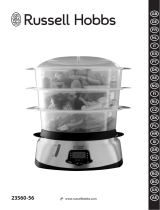
108
Read the instructions, keep them safe, pass them on if you pass the appliance on.
Remove all packaging before use.
A IMPORTANT SAFEGUARDS
Follow basic safety precautions, including:
1 This appliance must only be used by or under the supervision of a responsible adult. Use and
store the appliance out of reach of children.
2 Don’t put the base unit in liquid. Don’t use the appliance in a bathroom, near water,
or outdoors.
3 Don’t put frozen meat or poultry in the steamer – defrost fully before use.
4 Fill the reservoir to max (1.2l). If you overfill, it may spit boiling water and you may damage
the steamer.
5 Don’t touch the hot surfaces of the base unit, lid, baskets, rice bowl, or tray. Use oven gloves
or a cloth, and lift them only by the handles.
6 Don’t reach over the appliance, and keep hands, arms, face, etc. clear of the escaping steam.
7 This appliance must not be operated by an external timer or remote control system.
8 Don’t cover the appliance or put anything on top of it.
9 Don’t line the baskets with paper, foil, etc. – you’ll block the steam holes.
10 Unplug the appliance when not in use, before moving and before cleaning.
11 Let the appliance cool down fully before moving or cleaning.
12 Don’t use accessories or attachments other than those we supply.
13 Don’t use the appliance for any purpose other than those described in these instructions.
14 Don’t operate the appliance if it’s damaged or malfunctions.
15 If the cable is damaged, it must be replaced by the manufacturer, its service agent, or
someone similarly qualified, in order to avoid hazard.
household use only
C PREPARATION
1 Sit the appliance on a stable, level, heat-resistant surface.
2 Route the cable so it doesn’t overhang, and can’t be tripped over or caught.
3 Steam will escape. Don’t put the appliance near curtains, under shelves or cupboards, or near
anything that might be damaged by the escaping steam.
4 Have plates or a tray handy to put the baskets on afterwards, as they’ll drip. This would be a
good time to set out serving spoons, tongs, etc. for emptying the baskets. Don’t forget the
oven gloves.
C FILLING
5 Fill the reservoir to max (1.2l). This’ll give you about 60 minutes steaming, enough time for
most foods.
6 Don’t add anything to the water. Seasonings, marinades, etc. should be added to the food,
not the steaming water. They won’t circulate with the steam, they’ll just concentrate in the
reservoir, possibly damaging the surfaces of the reservoir and element.
7 Fit the steam tube round the element, so that the element is in its centre.
8 Sit the tray on the base unit.
9 The tray fits only one way round, to allow for the control panel. It prevents juices from the
food reaching the element and reservoir.
10 The basket handles are marked 1, 2, and 3. You may use 1, 2, or 3 baskets at a time.
a) Fit basket 1 on top of the tray
b) Put food in the basket.
c) Fit basket 2 on top of basket 1.
d) Put food in the basket.






